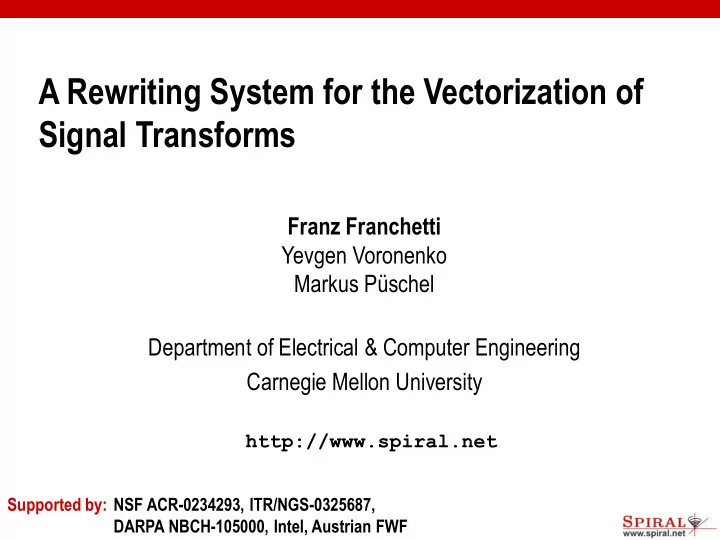

A Rewriting System for the Vectorization of Signal Transforms Franz Franchetti Yevgen Voronenko Markus Püschel Department of Electrical & Computer Engineering Carnegie Mellon University http://www.spiral.net Supported by: NSF ACR-0234293, ITR/NGS-0325687, DARPA NBCH-105000, Intel, Austrian FWF
The Problem (Example FFT Performance) best available implementation (FFTW, Intel IPP, Spiral) 10x roughly the same operations count reasonable implementation (Numerical recipes. GNU scientific library) Solution: program generators like Atlas and Spiral, adaptive libraries like FFTW
Organization Spiral overview SIMD vector instructions Vectorization by rewriting Extension to SMP and Multicore Experimental results Summary
Spiral Program generation from a problem specification for linear digital signal processing (DSP) transforms (DFT, DCT, DWT, filters, ….) Goal 1: A flexible push-button program generation framework for an entire domain of algorithms Goal 2: With new architectures, update the tool rather than the individual programs in the library Spiral: generates DSP programs for SIMD vector, shared memory, Principle 1: Domain knowledge in the system Knowledge of the platform: By evaluating runtime Principle 2: Optimization at a high level of abstraction multicore, distributed memory, FPGAs, embedded CPUs Markus Püschel, José M. F. Moura, Jeremy Johnson, David Padua, Manuela Veloso, Bryan Singer, Jianxin Xiong, Franz Franchetti, Aca Gacic, Yevgen Voronenko, Kang Chen, Robert W. Johnson, and Nick Rizzolo, SPIRAL: Code Generation for DSP Transforms, Proceedings of the IEEE 93(2), 2005
What is a DSP Transform? Mathematically: Matrix-vector multiplication input vector (signal) transform = matrix output vector (signal) Example: Discrete Fourier transform (DFT)
DSP Algorithms: Example 4-point DFT Algorithm = sparse matrix factorization Reduce computation cost from O( n 2 ) to O( n log n ) For every transform there are many fast algorithms 12 adds 4 adds 1 mult 4 adds 4 mults (when multiplied with input vector x ) SPIRAL generates the space of algorithms using breakdown rules in the domain-specific Signal Processing Language (SPL)
Some Transforms Spiral currently contains 45 transforms
Some Breakdown Rules Base case rules Spiral currently contains 165 rules
SPL (Signal Processing Language) SPL expresses transform algorithms as structured sparse matrix factorization Examples: Kronecker product = loop (parallel, vector) for i = 0:n-1 y[im:im+m-1] = B·x[im:im+m-1] endfor
Formula Level Optimization: Idea Move optimizations to higher abstraction level: Domain knowledge overcomes compiler limitations Formulas Code Traditionally optimizations by C/Fortran compilers Formula level optimizations in Spiral: Loop merging Implemented through rewriting systems Vectorization Parallelization
SIMD (Signal Instruction Multiple Data) Vector Instructions in a Nutshell What are these instructions? Extension of the ISA. Data types and instructions for parallel computation on short (2-way – 16-way) vectors of integers and floats vector register Intel MMX xmm0 1 2 4 4 5 1 1 3 xmm1 AMD 3DNow! Intel SSE vector operation + + + + AMD Enhanced 3DNow! addps xmm0, xmm1 Motorola AltiVec xmm0 6 3 5 7 AMD 3DNow! Professional Itanium Problems: Intel XScale Not standardized Intel SSE2 AMD-64 Compiler vectorization limited IBM BlueGene/L PPC440FP2 Low- level issues (data alignment,…) Intel Wireless MMX Intel SSE3 Reordering data kills runtime … One can easily slow down a program by vectorizing it
Vectorization of Formulas by Rewriting Naturally vectorizable construct Franchetti and Püschel (IPDPS 2002/2003) A 4 A 4 A 4 A 4 A 4 A 4 A 4 A 4 Operates on 4-way vectors vector length (any two-power) Rewriting rules to vectorize formulas Introduces data reorganization (permutations) vector construct further rewriting base case Definition: Vectorized formula := vector constructs and base cases, A ¢ B , and IA of vectorized formulas
Example: DFT vector constructs base cases Formula is vectorized w.r.t. Definition
Some Vectorization Rules
Shared Memory Parallelization by Rewriting Load balanced, contiguous blocks No false sharing (entire cache lines are swapped) F. Franchetti, Y. Voronenko, and M. Püschel: “FFT Program Generation for Shared Memory: SMP and Multicore,” to appear in SC|06
How Good is Our Generated Vector Code? Complex 1D DFT on Intel Pentium 4, 3.6 GHz, 4-way SSE (float) 9000 9000 9000 Spiral vector code 8000 8000 8000 (automatically generated) 7000 7000 7000 Intel MKL 8.1 6000 6000 6000 pseudo Mflop/s pseudo Mflop/s pseudo Mflop/s (handcoded) FFTW 3.1 SSE 5000 5000 5000 3.5x (adapted, but scalar Spiral code + vectorizing compiler hand-vectorized) 4000 4000 4000 3000 3000 3000 better 2000 2000 2000 scalar (x87) Spiral code 1000 1000 1000 (automatically generated) 0 0 0 4 5 6 7 8 9 10 11 12 13 14 15 16 17 4 5 6 7 8 9 10 11 12 13 14 15 16 17 4 5 6 7 8 9 10 11 12 13 14 15 16 17 problem size (log2 N ) problem size (log2 N ) problem size (log2 N ) Spiral generated code performs comparable to expertly hand-tuned code
What About 8-way Vector Code? Complex 1D DFT on Intel Pentium 4, 3.6 GHz, 8-way SSE2 (16-bit int) 16000 14000 Spiral vector code (automatically generated) 12000 10000 MIPS 8000 Intel IPP 5.0 (handcoded) 6000 4000 better 2000 0 64 128 256 512 1024 2048 4096 8192 problem sizes (N) Spiral generated code clearly outperforms expertly hand-tuned code
Combined Multicore and Vector Code Pentium D 3.6 GHz (Dual Core, 2-way SIMD), double precision 1-D DFT 6000 parallel + vector 5000 4000 2.5x pseudo Mflop/s parallel 3000 2000 sequential better 1000 0 7 8 9 10 11 12 13 14 15 16 17 18 19 20 problem size (log2 N) 2.5x speed-up from parallel + vector Parallelization speed-up for small problems
Summary Parallelization and vectorization in Spiral Entirely automatic Principled approach Rewriting system Generated code is very fast Works for other hardware as well Distributed memory: MPI with C.W. Ueberhuber, A. Bonelli, and J. Lorenz, Vienna University of Technology Hardware: FPGAs with J.C. Hoe and Peter Milder, Carnegie Mellon University
(Part of the) Spiral Team www.spiral.net
Recommend
More recommend